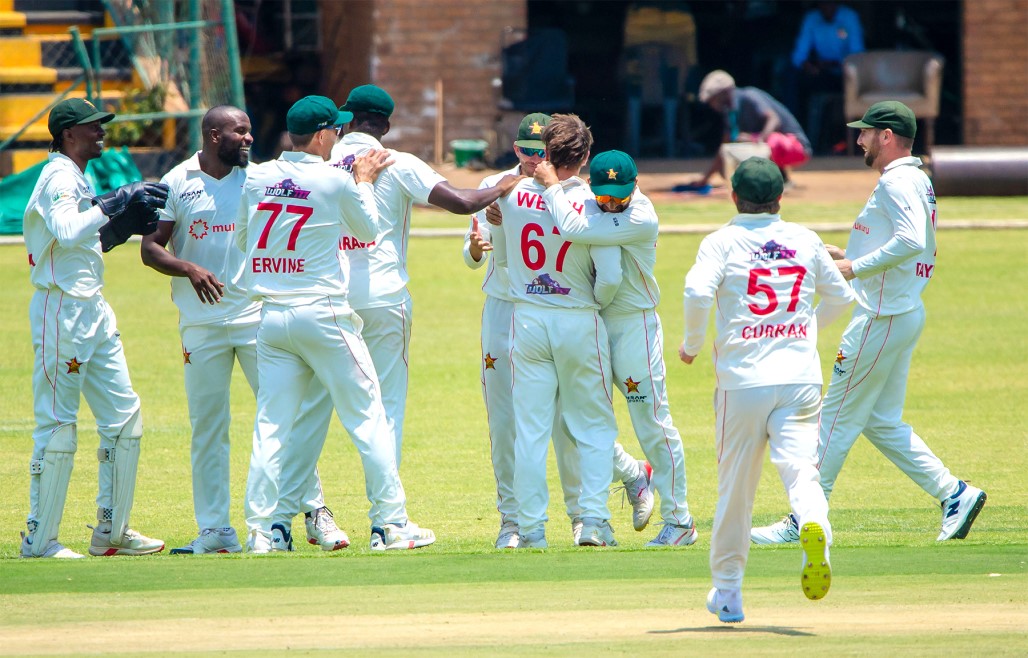Copyright 3-mob

It was about an hour after lunch on day three that the tall, lanky figure of Blessing Muzarabani loomed over an expectant Harare Sports Club. Afghanistan’s Zia Sharifi had walked out following Khalil Gurbaz, who had just been sent back upstairs, stumps knocked over by the speed merchant. Muzarabani took three balls to consign the debutant to the same fate as the man before to claim Zimbabwe a victory by an innings and 74 runs, the biggest-ever margin of victory in their Test history. Cast your eyes back to 2013, the 14th of September, to be exact, at the same venue. A young Tendai Chatara sauntered down the track, delivering one that stayed low and rapped Saeed Amal on his pads. The dreaded finger went up. Chatara had his fifer, and Zimbabwe had beaten Pakistan by 24 runs to square the series. That was the last time Zimbabwe had won a home Test, a whole 12 years ago. Incidentally, that 2013 victory was a milestone of its own, the first against a full member other than Bangladesh, also in 12 years. And yet, where Zimbabwe finds itself now, compared to then, is almost two different worlds. The context of both victories The worlds they were in could not have been further apart. The scene for Zimbabwe then was a team which had just come out of the wilderness, a self-imposed exile from Test cricket. In 2025, Zimbabwe is increasingly seen by many as a resurgent force, one able to, on its day, compete or beat against most of those around it and a little higher. Optimism: Then vs Now In 2013, despite the win, an article by ESPNcricinfo’s Firdose Moonda painted a bleak picture for what would come next. The phrase she used was ‘disappear from the international stage. The win came amid player strikes. The second Test almost didn’t go ahead after players threatened to boycott the match over unpaid salaries. Forward to 2025. Zimbabwe has played ten Tests, not least against teams at the top table in World Test Champions South Africa, the ruthless New Zealand and that historic visit to England. Captain Craig Ervine said: “I’m ecstatic. A lot of credit to the boys for fighting hard throughout the year… The boys have learnt with the Test cricket they’ve played in the last six-seven months to find their game”. And in a few weeks, Zimbabwe is off to Pakistan for a triangular T20I series involving Sri Lanka. Add to that, Zimbabwe is co-hosting the ICC Men’s Under-19 Cricket World Cup 2026 in January, showing the International Cricket Council’s (ICC) confidence in the country’s infrastructure and expertise. Financial Stability: Crisis versus recovery In 2013, players threatened to strike during the ODI series against Pakistan. The pay dispute intensified in December 2013 when players went on strike, leading to the suspension of four-day and one-day tournaments. The cricket board was deep in debt and reportedly had to move the that second Test venue from Bulawayo to Harare to save USD50,000 in expenses. The late Heath Streak’s contract wasn’t renewed in 2013 for financial reasons, despite him being the bowling coach. Moving forward to 2025, Zimbabwe Cricket is in the black, investing in infrastructure. Threats of player boycott over pay are a thing of the past. Regular fixtures and hosting capabilities are proof of better financial management. Domestic Structure: Rebuilding the foundation In recent times, ZC has helped reform and revive club cricket, culminating in a National Premier League (NPL). Launched in 2020 as “an elite strength versus strength competition at club level”, it expanded to 14 teams (up from nine initially), with 91 games played across the country. It has featured top local talent like Sikandar Raza, Richard Ngarava, Muzarabani, Craig Ervine, and Brian Bennett. The majority of the teams have to qualify from their provinces, which means the game is being played across the country. Add to that the provincial structures, with the Logan Cup about to enter its 32nd season. The 2025/26 season begins on 26 October, with back-to-back Logan Cup and Pro50 Championship fixtures designed to give players maximum exposure. Add to that the Domestic T20. All these are regular fixtures providing predictable cricket for the players. What is more, these provide a pathway for development. While Zimbabwe still have a long way to go until they can become a top or at least middle-tier Test nation, there is a lot to be excited about. As one pundit often says, he has been involved, on and off, with Zimbabwe Cricket for at least 35 years. This, he insists, is the strongest it has ever been. What remains now is to build on that strength. And that is what will be the continued trajectory expected from the Tavengwa Mukuhlani board and the secretariat headed by Managing Director Givemore Makoni. Subscribe to Blog via Email



